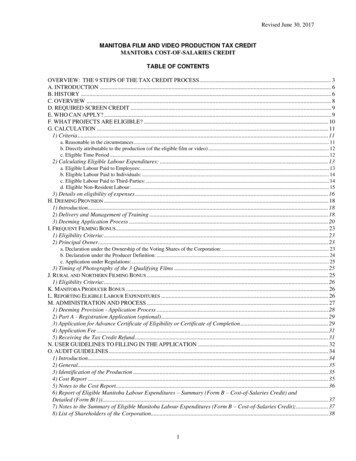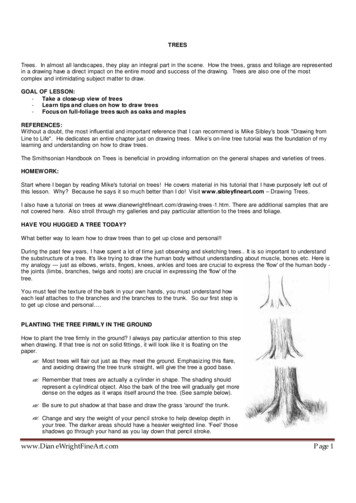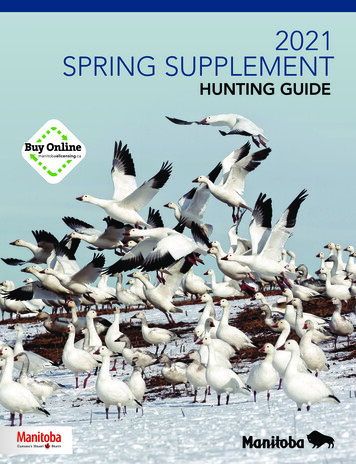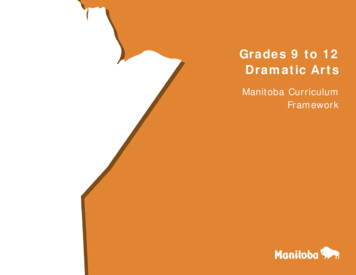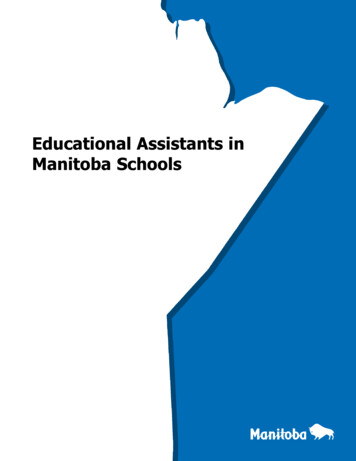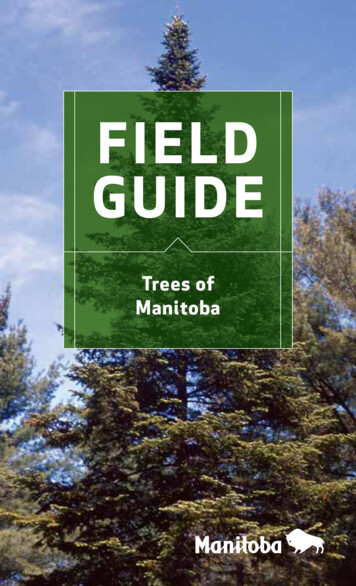
Transcription
F I ELDG UI D ETrees ofManitoba
TABLE OFCONTENTSManitoba’s Ecozones2Deciduous Trees36Sustainable ForestManagement4American Elm(White Elm)38IdentifyingManitoba Trees7Balsam Poplar(Black Poplar)40Manitoba TreeSilhouetes8Basswood (Linden)42Black Ash44Bur Oak (Scrub Oak)46Cotonwood48Green Ash50Hackberry52Hop-Hornbeam(Ironwood)54Largetooth Aspen56Manitoba Maple(Box-Elder)58Peachleaf Willow60Showy Mountain Ash62Trembling Aspen(White Poplar)64Acknowledgements10Using This Guide10Illustrated Terms12Guide to trees basedon their leaves14Guide to trees basedon their winter twigs16Coniferous Trees18Balsam Fir20Black Spruce22Eastern White Cedar24Eastern White Pine26Jack Pine28Red Pine30Tamarack (Larch)32White Spruce34White Birch(Paper Birch)66Wild Plum68
MANITOBA’SECOZONESManitoba is divided into six ecozones: boreal plains, borealshield, Hudson plains, prairie, southern arctic and taiga shield.Each zone has its own characteristics, including native trees.BOREAL PLAINSThe boreal plains ecozoneconsists of plains andvalleys. Much of it is forestedwith spruce, balsam fr andjack pine. Broadleaf treessuch as aspen and poplarare common.BOREAL SHIELDThis zone is dominatedby forests. The dominantconiferous species areblack spruce, jack pine,white spruce, tamarack andbalsam fr. Trembling aspen,white birch and balsampoplar are the most commondeciduous species.HUDSON PLAINSThe northern part of thisecozone is largely treeless,though areas further southgrow open forest. Southern,wet locations grow willow,tamarack and black spruce.SOUTHERNARCTICTAIGASHIELDPRAIRIEThis zone is dominated byfat plains, the majority ofwhich is used for agriculture.The north prairie ecozonefeatures trembling aspenand balsam poplar.HUDSONPLAINSSOUTHERN ARCTICOf the arctic ecozones,this ecozone has the mostextensive vegetation coverand the highest diversity ofspecies. It is characterizedby dwarf shrubs.TAIGA SHIELDIn the taiga shield, much ofthe forest is open, and treegrowth is ofen stunteddue to permafrost and coldtemperatures. Black spruceand jack pine dominate,though trees such astrembling aspen and whitebirch can be found.BOREALSHIELDBOREALPLAINSPRAIRIE3
SUSTAINABLEFORESTMANAGEMENTSustainable forestmanagement is a wayof using and caring forforests to maintain theirenvironmental, social,and economic valuesand benefts.Sustainable forestmanagement balancesthe demand for naturalresources and the vitalityof the forest.In Manitoba, sustainableforest managementdecisions and activities arebased on scientifc research,rigorous planning processesand public consultation. Inthis way, sustainable forestmanagement protectsthe long-term value ofthe forest.Sustainable forestmanagement ensures thatforests are available forgenerations to come.5
IDENTIFYINGMANITOBA’S TREESAlthough many trees maylook alike, a closer inspectionof their leaves and twigs willreveal their character anddistinctiveness.In Manitoba, there are 24native trees. While some areseen only in localized areas,the majority are within ahalf-day’s drive from mosthomes. This feld guide willhelp readers understandwhat features to look for inorder to easily identify all24 native Manitoba trees.When identifying trees, it isimportant to note that notall members of the samespecies will look alike. Forexample, trees growing indense forest will shed theirlower branches. They will bemore pole-like and narrowerthan trees growing in openareas. Some trees that growtall in one area may hardlydevelop into more than ashrub in another. The shapeof a tree alone, therefore, isnot always the best guide foridentifcation. Leaf shape,bud growth, bark, fowers,and cones should also beused. As well, very youngtrees have diferent forms,leaf stages, etc. from theirmature characteristics.In this guide, a tree isgenerally defned as awoody plant having onewell-defned trunk and arecognizable crown. It mustgrow to a minimum height of4.5 metres at maturity andhave a trunk diameter of notless than fve centimetres.7
MANITOBA TREESILHOUETTESTrees may look alike, however, a closer inspection of theirsilhouete will reveal their unique characteristics.' ! t' t ' BALSAMFIRBLACKSPRUCEEASTERN WHITECEDARBUROAKCOTTONWOODGREENASHEASTERN TOOTHASPENWHITESPRUCE.AMERICANELM," t,,-,,,; '.,, . 1 MANITOBAMAPLEPEACHLEAFWILLOWSHOWYMOUNTAIN ASHTREMBLINGASPENWHITEBIRCHWILDPLUM, '.; '',I.',TAMARACK .IBALSAMPOPLARBASSWOODBLACKASH9
ACKNOWLEDGEMENTSManitoba SustainableDevelopment thanksMr. Oswald, Mr. Nokes, andthe Canadian Forest Servicefor producing the originalpublication of the feld guidein 1979.The Department also thanksIndigenous Languages ofManitoba Inc. for providingCree, Dakota, Dene, Michif,Ojibwe and Ojibwe-Creetranslations in 2019.In some instances,indigenous languagetranslations are unavailable.For example, Dene(a language spoken in thenorth), does not have atranslation for whitepine, which grows in theextreme south east cornerof Manitoba.USING THIS GUIDEThis booklet provides manyways to identify trees usingtree silhouetes, bark, leavesand winter twigs.First, familiarize yourselfwith the terms used in thisguide. Look at the treesilhouete and compare itto the ones in this guide.Next, use the charts on thefollowing pages to helpidentify the tree.Look at the leaf shape andidentify the buds and theway they grow on the twig. Inthe winter, you can use twigsto identify the tree.To confrm treeidentifcation, turn to thefull description of the tree inthis book and compare otherdetails such as general form,bark and distribution.11
ILLUSTRATED TERMSA graphic guide to technical terms found in this book.SimpleleafTerminalbudCompoundleafLeaf BudsagainsttwigBuds awayfrom eaf bases onspruce twigLeafdouble-toothedBudsalternateSpurs ontamarack twigLeaflobed13
Guide to trees based on their leavesLEAVES (L) BROAD, FLATL. COMPOUNDL. SIMPLELEAVES (L) NEEDLE OR SCALE-LIKEL. NEEDLE-LIKEL. SCALE-LIKELFTS. *7 OR MOREnot lobedL. IN CLUSTERS OF 2-10L. OPPOSITEON BRANCHL. ALTERNATEON BRANCHBALSAM FIRNEW TWIGS HAIRYTWIGS NOT HAIRYBLACK SPRUCEWHITE SPRUCEL. IN CLUSTERS OF 2L. UNDER 2"L. 5 IN A CLUSTERCLUSTERS 10 OR MORERED PINEJACK PINEE. WHITE PINETAMARACKBUR OAKL. DOUBLE-TOOTHEDL. LOP-SIDEDL. EQUAL AT BASEAMERICAN ELMLFTS. NO STALKSLFTS. WITH STALKSL. USU. TRIANGULARBLACK ASHGREEN ASHWHITE BIRCHL. OVAL-SHAPEDL. UNDERSURFACE NOT HAIRYL. UNDERSURFACE FINELY HAIRYWILD PLUMHOP-HORNBEAML. IN CLUSTERS OF 5 OR MOREL. 4" OR LONGERL. NOT LOBEDSHOWY MOUNTAIN ASHL. SOFT, FLATL. STIFF, 4-SIDEDL. LOBEDMANITOBA MAPLEE. WHITE CEDARL. SINGLE ON BRANCHLFTS. 3–5some lobedL. SINGLE-TOOTHEDL.EQUAL AT BASELEAVES WIDEL. LOP-SIDEDL. NARROWL. STALKS ROUNDPEACHLEAF WILLOWBALSAM POPLARL. STALKS FLATTEETH SMALLTEETH LARGETREMBLING ASPENL. NEARLY ROUNDLARGETOOTH ASPENTEETH SMALLTWIGS HAIRYHACKBERRYTEETH LARGETWIGS NOT HAIRYBASSWOOD*LFTS. LEAFLETSL. TRIANGULARCOTTONWOOD15
Guide to trees based on their winter twigsBUDS OPPOSITETWIGS HAIRYTWIGS NOT HAIRYMANITOBA MAPLEBUDS ALTERNATESPURS ALONG TWIGTWIGS NO SPURSTAMARACKBUDS BLACKBUDS RUSTY BROWNBUDS STICKYBUDS NOT STICKYBLACK ASHGREEN ASHBUDS HAIRYBUDS NOT HAIRYSHOWY MOUTAIN ASHTWIGS FUZZY OR HAIRYLENTICELSROUNDLEAF SCARSHOP-HORNBEAMLATERAL BUDSAGAINST TWIGLENTICELSELONGATEDLEAF SCARSWILD PLUMLATERAL BUDSAWAY FROM TWIGHACKBERRYTWIGS RIDGEDTWIGS SMOOTHCOTTONWOODBALSAM POPLARTWIGS NOT FUZZY OR HAIRYTIPS WITH3–4 BUDSBUR OAKTWIGS SMOOTHMANYLENTICELSTIPS WITHSINGLE BUDTWIGS WRINKLEDBASSWOODFEWLENTICELSWHITE BIRCHTERMINAL BUDBLUNTTERMINAL BUDSHARPBUDS SINGLESCALEBUDS MANYSCALESAMERICAN ELMLARGETOOTHASPENPEACHLEAFWILLOWTREMBLINGASPEN17
ConiferousTrees
BALSAM FIRAbies balsamea (L.) Mill.Cree: NapakátikMichif: LyayrOjibwe: Zhingob(iig)Ojibwe-Cree: NapakaantakFORMA moderately denseevergreen tree with aslender symmetricalspire-shaped crown.BARKGrey, smooth-to-roughened byraised resin blisters on youngtrees, becoming cracked andscaly on older trees.TWIGSOpposite, grey, slender,smooth, more or less hairy.Buds about 5 mm withgreenish-brown scalescovered with resin.LEAVESSingle, fat, twisted at base,needle-like, sof, roundedor notched at tip, 15–25 mmlong, usually spreading intoone plane; whitened belowalong two lines.FLOWERSApril-May, solitary from baseof previous year’s leaves, redor purple, oval.FRUITAn erect, oblong, darkpurple cone with thin scalesatached to upper side ofbranches, 4–10 cm long;disintegrating at maturityleaving cone axis on branch.OCCURRENCEFairly common throughoutforested region, exceptextreme north, in moisthabitats; usually mixed withother tree species.NOTESThe needles and sap arefammable and can helpto start a fre.21
BLACK SPRUCEPicea mariana (Mill.) B.S.P.Cree: Kakitéwi MinahikDene: EhlMichif: La nipinet nwayrOjibwe: ZesegaandagOjibwe-Cree: ShikopFORMA dense evergreen tree; crowngenerally irregularly pyramidaland symmetrical but tip ofenclub-shaped; lower branchesdrooping, lowest brancheswith tips upturned.BARKThin, brown-to-greyishscales; inner bark olivegreenish tinged.TWIGSIrregularly whorled, hairy, lightbrown when young, darkeningwith age, roughened byoutward pointing leaf bases.Buds slightly hairy, 3–5 mmlong with many overlappingbrown scales.LEAVESSingle, short stalked, sharppointed, stif, four-sided,bluish green, whitened alongsides, needle-like, about8–15 mm long.FLOWERSMay, solitary on precedingyear’s twig, dark red orpurple, oval.FRUITEgg-shaped cones about2–3 cm long with thin brownscales, usually remain on thetree for more than one year;most trees have a cluster ofpersistent cones near the top.OCCURRENCEWide-spread throughoutthe forested region; in thesouth mostly in bogs or wethabitats but ofen on mineralsoil in the west and north.NOTESLong ago, parts of the treewere used to make dollsfor children.23
EASTERNWHITE CEDARThuja occidentalis L.Cree: Místi Wápi MásikéskátikDakota: Khante chanOjibwe: GiizhikaatigFORMA dense, compact evergreentree with a cone-shapedcrown, ofen occurring inclumps.BARKThin, shreddy, with narrowelongated fbrous strips;reddish-to-pale brown.TWIGSAlternate, slender, fatened,fan-shaped, covered withgreen sharp-pointed scalesthat become brown withage and shed in three to fouryears. Leaf buds are coveredwith leaves but cone budsslightly emerge at tips ofsome branches.LEAVESScale-like, paired,overlapping, short, 3–6 mm,tight against the twigs,yellowish green in colour.FLOWERSMay, solitary at tip of twig,yellow or pink, small and oval.FRUITAn oblong erect cone about12 mm long with 4–6 pairsof thin, brown, roundedcone scales.OCCURRENCEMostly in wet habitats insoutheastern Manitobabut occasionally betweenLake Winnipeg and LakeWinnipegosis as far northas Grand Rapids.NOTESOne of Manitoba’s oldesttrees, it can grow up to 400years old.25
EASTERNWHITE PINEPinus strobus L.Cree: Místi Wápi MinahikDakota: WazichanOjibwe: ZhingwaakOjibwe-Cree: MinahikFORMA medium-sized evergreentree with a broadlycylindrical-to-irregularcrown when open-grown;narrower in closed stands.LEAVESNeedle-like, sof, 5–15 cmlong, fnely-toothed, inclusters of fve with adeciduous brown sheathat base.BARKThin, smooth, greyish-greenwhen young, becomingrough, dark grey, deeplyfurrowed with scaly ridges.FLOWERSMay, in clusters near tip oftwig, yellowish or pinkish, oval.TWIGSOpposite or whorled,slender, greenish-grey,roughened by leaf basesat frst but becomingsmooth and brown. Buds15 mm long with light brownpointed scales.FRUITCone, almost cylindrical andsometimes curved,8–20 cm on curved stems;cone scales thin, brown andnot barbed.OCCURRENCEExtreme southeasternManitoba in dry habitats; rare.NOTESWere used to produce RoyalNavy ship masts.27
JACK PINEPinus banksiana Lamb.Cree: OskatátikDene: GenehDakota: WazichanMichif: Aen pinetOjibwe: AkikaandagOjibwe-Cree: OhkihkaahtikFORMA medium-sized evergreentree with a narrow, opencrown; crown rather small indense stands but becomesbushy and extends near theground in open areas.BARKBrownish with thin,irregularly furrowed scales.TWIGSWhorled, reddish-brown,slender, usually with narrowelongated ridges, slightlyroughened by leaf bases. Budsabout 15 mm long, with manysmall, brown, sticky scales.LEAVESNeedle-like, 2–4 cm long,stif, in clusters of two witha brown sheath at base,sometimes minutely toothed.FLOWERSMay, in clusters near tipof twig, yellow or purple,elongated.FRUITA brown cone, 3–7 cm long,usually curved, occurring inpairs, scales thickened at tips,cones persist on the trees,usually remaining closed.OCCURRENCEVery common in dry to moisthabitats throughout theforested region.NOTESThe cones are serotinous,meaning that they open inhigh heat from the sun or fre.29
RED PINEPinus resinosa Ait.Cree: NikwátikoDakota: WazichanMichif: Pinet roozhOjibwe: ZhingwaakBapakwanagemagFORMA large evergreen tree witha round, symmetrical, opencrown; devoid of lowerbranches especially in densestands, branches nearlyhorizontal.BARKReddish-brown with smooth,broad, scaly plates.TWIGSOpposite or single, lightbrown but soon darkening,stout, roughened byprojecting leaf bases. Budsup to 2 cm long with manyreddish-brown scales withtips turned back.LEAVESNeedle-like, 10–16 cm long,in clusters of two with abrown sheath at base, sof,minutely-toothed.FLOWERSMay, in clusters near tipof twig, red or purple,elongated.FRUITA stalkless, egg-shapedcone, 4–7 cm long; scalesthickened at outer edge butnot barbed.OCCURRENCEIn dry habitats insoutheastern Manitoba,also on Black Island, LakeWinnipeg; not common.NOTESSeen most commonly inplantations in the southeastforests of Manitoba.31
TAMARACK(LARCH)Larix laricina (Du Roi) K.KochCree: WákinátikDene: NidhehMichif: TamarackOjibwe: MashkiigwaatigOjibwe-Cree: MashkiikwaahtikFORMA small tree with anopen, light-green, usuallysymmetrical crown. The onlynative conifer that loses itsneedles each autumn.TWIGSAlternate, slender, fexible,slightly hairy, light-brownbut darkening with age;roughened by thin scaleswith upturned tips. Budswith numerous small scales,elevated on spurs on olderbranches.LEAVESNeedle-like, 20–50 mm long,in sheathless clusters of12 to 20 from spurs on olderbranches, sof, fexible, palegreen in summer and turningyellow in autumn.FLOWERSWith leaves, solitary on shortspurs, yellow or red, small,semi-circular.FRUITErect, egg-shaped brownishcone, 1–5 cm long, composed ofabout 20 rounded thin scales.OCCURRENCEIn bogs and wet habitatsthroughout most of theforested region.NOTESThe bark and roted woodcan be burned to smoke fshand hides.33
WHITE SPRUCEPicea glauca (Moench) VossCree: MinahikDene: Tzu’choMichif: La nipint blaanOjibwe: ZesegaandagFORMA dense evergreen tree witha pyramidal crown composedof horizontal branches, ofenthe lower branches havingupturned tips.BARKThin, grey-to-brown scalesthat fake of readily on oldertrees; inner bark cinnamonto light silvery-white.TWIGSIrregularly whorled,yellowish-brown, becomingdarker with age, covered withsmall, elongated, spirallyarranged leaf bases makingtwigs and branches rough.Buds 6 mm long with manyoverlapping brown scales.LEAVESSingle, sharp-pointed, needlelike, stif, four-sided, whitenedalong sides, up to about 15 mmlong; more numerous on upperside of twig.FLOWERSMay, solitary on precedingyear’s twig, red or yellow, oval.FRUITCones which usually dropin one year but some ofenpersist scatered about thecrown; 3–6 cm long; scalesbrown, thin.OCCURRENCECommon throughout theforested region on welldrained habitats or alongstreams and around lakes.NOTESWhite spruce is theprovincial tree of Manitoba.This wood can be used forwood frames, snowshoes,tent poles; and its pitch canbe used to seal the joints ofbirch bark canoes.35
DeciduousTrees
AMERICAN ELM(WHITE ELM)Ulmus americana L.Cree: Wápiski AcapaskátikDakota: Wagha chan/tazhushka chanOjibwe: AniibFORMA large deciduous tree,slender in dense standsbut branching from nearthe ground in open areas,its large limbs spread togive it a graceful, vase-likeappearance.BARKDark-grey, rough, furrowedwhen old.TWIGSAlternate, slender, smoothor hairy; terminal budsconical, about 5 mm long,reddish-brown, somewhathairy; lateral buds smaller.Flower buds rounded, larger.Leaf scars nearly oval, tan,with about fve prominentbundle scars acrossmiddle. Lenticels common,yellowish-brown, elongated.LEAVESAlternate, simple, oval,sharp-pointed, unequalat base, coarse doubletoothed, 10–15 cm long.FLOWERSBefore leaves, small, purplishor yellowish, on long stems inloose drooping clusters.FRUITOval, dry, one-seeded,fatened, winged with ahairy margin, about 8–10 mmin diameter, usually notchedat tip.OCCURRENCESouthern Manitoba on rich,moist, well-drained habitats.NOTESKnown for its susceptibilityto Dutch elm disease, afungus that causes the treeto wilt and die.39
BALSAM POPLAR(BLACK POPLAR)Populus balsamifera L.Cree: MayimítosDakota: Yatkanpi chanOjibwe: MaanazaadiFORMMedium-sized deciduoustree with long cylindricaltrunk and a narrow, opencrown of stout limbs.BARKSmooth, becoming furrowedinto thick ridges, whitish togreyish-brown.TWIGSAlternate, moderately stout,round, shiny, smooth, brightreddish-brown. Lenticelsfew, mostly inconspicuous.Terminal bud sharp, pointed,up to 25 mm long, shiny, verygummy with a fragrant odour,chestnut-brown; lateral budssmaller, pressed against twig.Leaf scars moon-shaped,small, with three bundle scars.LEAVESAlternate, simple, oval,tapering to tip, roundedat base (or heart-shapedat base in var. subcordataHylander), fne-toothed,7–10 mm long, with ayellowish metallic lustre onundersurface.FLOWERSBefore leaves, in droopingdense catkins.FRUITWith leaves, smooth, capsuleabout 6–7 mm long, in catkins.OCCURRENCEThroughout moist habitatsin the forested ecozones ofManitoba; except extremenorth.NOTESThe aromatic buds of balsampoplar have been called thebalm of Gilead.41
BASSWOOD(LINDEN)Tilia americana L.Cree: NapakátikOjibwe: WiigobFORMMedium-to-large deciduoustree, varies from a single,straight trunk with narrowor long pyramid crown;sometimes divided trunkswith two or more heavy,wide-spreading limbs.BARKDark grey, smooth on youngtrees; but becoming furrowedinto sof, fat scaly ridges.TWIGSAlternating, smooth, shinyred or green, wrinkled.Lenticels are common,elongated, rusty-brown.Terminal bud is broad, about6 mm long, greenish-brown,shiny, composed of two tightscales and one lateral scalethat is somewhat separatedfrom others, making it longsided; lateral buds similarbut smaller. Leaf scarsmoon-shaped, brown, bundlescars few.LEAVESAlternate, simple, heartshaped, abruptly pointed attip, coarsely toothed, lopsided, 12–16 cm long.FLOWERSWith leaves or later, creamcoloured, fragrant.FRUITA pale-brown, hard, nut-likeberry, about 1 cm in diameter,in small open clusters,droops from an elongated,smooth-margined leaf.OCCURRENCESouthern Manitoba; fromSpruce Woods eastward,along river banks.NOTESBasswood is a source ofnectar for bees.43
BLACK ASHFraxinus nigra Marsh.Cree: Kakitéwi MaskominátikDakota: Pse khti chan sapaMichif: Li frenn nwayrOjibwe: BaapaagimaakFORMMedium-to-large deciduoustree with narrow open crown.BARKGreyish, scaly, shallowfurrowed into sof, ofenspongy, ridges.TWIGSOpposite, round, stout,smooth, grey. Terminal budabout 4–10 mm long, darkbrown to black, pointed withtwo large lateral scales;lateral buds smaller, nearlycircular. Leaf scars heartshaped to nearly circular,prominent, with a line ofprominent bundle scarsfollowing contour of leafscars. Lenticels elongated,yellowish-to-dark brown.LEAVESOpposite, compound,15–30 cm long, composedof 7 to 11 lance-shaped, fnetoothed leafets, 10–14 cmlong, stalkless and arrangedin pairs.FLOWERSBefore leaves, small, inclusters.FRUITSingle, dry, with elongatedwing, 2.5–4 cm long, blunt atboth ends.OCCURRENCESoutheastern Manitoba toLake Manitoba, along streambanks and in moist habitats.NOTESAsh trees are considered atrisk because of the threat ofemerald ash borer.45
BUR OAK(SCRUB OAK)Quercus macrocarpa Michx.Cree: MaskawátikMichif: La shennOjibwe: MitigomizhFORMA small-to-medium sizeddeciduous tree with a broad,rounded crown composedof variously spreading stoutbranches.BARKLight brown, rough, dividedby deep furrows into scaly,faky plates.TWIGSAlternate, stout, ridged,hairy at frst but becominghairless. Lenticels small,oval, yellowish-brown.Terminal bud hairy, about3–6 mm long, surrounded byfve narrow hairy bracts andtwo or more lateral buds;lateral buds about same size.Leaf scars moon-shaped,raised, brown; bundlescars in two curved rows,yellowish, not prominent.LEAVESAlternate, simple, prominentlylobed, 15–30 cm long, fnelyhairy beneath.FLOWERSAfer leaves, male in catkins,female single or few in acluster.FRUITAn acorn, 20–30 mmlong, half covered by cap,maturing in one year.OCCURRENCECommon in southernManitoba, north to The Pas;ofen in river botom forests,occasionally in uplands.NOTESOne of the longest livingdeciduous trees in Manitoba,sensitive to grounddisturbance.47
COTTONWOODPopulus deltoides Bartr.Cree: TasékátikDakota: Wagha chanFORMA large deciduous tree with aconical crown of spreadingto-ascending branches;sometimes the trunk willdivide near the ground andits massive limbs will form abroad open crown.BARKSmooth, yellow-green; olderbark deeply furrowed, scalyand grey at the base.TWIGSAlternate, stout, smooth,shiny, ofen four-sided orridged, greenish-brown.Terminal bud sharp-pointed,about 2 cm long, chestnutor greenish-brown, smooth,shiny, very gummy, outerscales hairy at base; lateralbuds similar, about 13 mmlong. Leaf scars roughlyelliptical, light greenishbrown; bundle scars in threeprominent groups. Lenticelscommon, elongated, strawcoloured.LEAVESAlternate, simple, triangular,with coarsely rounded teeth,somewhat hairy, 5–10 mmlong and about the samewidth, stalk fatened nearbase of leaf.FLOWERSBefore leaves, in droopingcatkins.FRUITA capsule about 8–12 mmlong, in catkins.OCCURRENCESouthern Manitoba, alongriverbanks.NOTESOne of the largest growingtrees in Manitoba,cotonwood can be severalmetres wide.49
GREEN ASHFraxinus pennsylvanica Marsh.Cree: AskátikDakota: Pse khti chan toMichif: Li frenn vayrOjibwe: Sagima’kwun AagimaakFORMMedium-to-large deciduoustree with a slender trunk andspreading crown.BARKGreyish-brown, furrowed intosof scaly ridges, a diamondpatern in mature bark.TWIGSOpposite, stout, smooth;lenticels brown, linear,common. Terminal budreddish-brown, about3–8 mm long with twoprominent lateral scales, nothairy; lateral buds smaller.Leaf scars horseshoeshaped with about 18 bundlescars in a single row andsame contour as leaf scar.LEAVESOpposite, compound,15–20 cm long, composedof 7–9 short-stalked, lanceshaped, coarse-toothed,leafets, 10–15 cm long, bornein pairs.FLOWERSBefore or with leaves, small.FRUITDry, single, with a narrow,elongated wing, 3–6 cm long,pointed at base.OCCURRENCECommon along river banksthroughout central andsouthern Manitoba.NOTESCommon as boulevard trees;Ash trees are considered atrisk because of the threat ofemerald ash borer.51
HACKBERRYCeltis occidentalis L.Cree: MínisátikFORMA small deciduous treewith large, bushy crownof ascending or spreadingbranches.BARKGreyish-brown, covered withdeeply furrowed, wart-likeridges when old.TWIGSAlternate, rusty-brownbecoming greyish-brown,slender, smooth or hairy.Buds about 6–8 mm long,hairy, light-brown, pressedagainst twig except forterminal bud that is at nearlyright angles to the twig. Leafscars small, oval, ofen raisedon short stalks; bundle scarsinconspicuous. Lenticelscommon, elongated, small,yellowish-brown.LEAVESAlternate, simple, oval tolance-shaped, 6–9 cm long,4–6 cm wide, tapered at tip,sharp-toothed to middleor below.FLOWERSBefore or with leaves,minute, greenish; solitaryor in pairs.FRUITA berry, about 6–8 mmin diameter, orange-redbecoming dark purple atmaturity and containing asingle hard nut.OCCURRENCELocalized along the southernmargin of Lake Manitoba,mainly on beaches; rare.NOTESHas a strong grain and porousstructure, and is used as asubstitute for red oak, ash orelm in furniture making.53
HOP-HORNBEAM(IRONWOOD)Ostrya virginiana (Mill.) K. KochCree: MaskawatikOjibwe: MaananoonsFORMA small deciduous tree witha slender, erect trunk; crownbroad, round-topped inopen areas; but narrow andpyramidal in dense stands.BARKLight-brown, roughenedby narrow, elongated,shreddy scales which loosenat the ends.TWIGSAlternate, very slender,tough, somewhat hairy,shiny, dark reddish-brown.Buds sharply pointed,chestnut-brown, about3–4 mm long, composed ofseveral scales with lightcoloured margins. Leafscars small, moon-shaped;bundle scars inconspicuous.Lenticels common, white,small, circular.LEAVESAlternate, simple, oval,tapered at tip, fnely doubletoothed, thin, 7–12 cm long,fnely hairy beneath.FLOWERSWith leaves; in greenishelongated clusters.FRUITA small greenish nut in apapery bladder, grows indense, elongated clusterson slender stems.OCCURRENCEIn southeastern Manitobain rich, moist habitats; rare.NOTESThis is a strong heavy wood,used for tool handles.55
LARGETOOTHASPENPopulus grandidentata Michx.Cree: WápasátikFORMA medium-to-tall deciduoustree with moderately stoutbranches that form a roundtopped crown.BARKSmooth, greenish-grey towhitish, becoming deeplyfurrowed at base of oldtrunks.TWIGSAlternate, moderatelystout, stif, somewhat hairy.Terminal bud, dull brown,fnely hairy, about 7–8 mmlong, pointed, lateral budsspreading away from twig.Flower buds larger. Leafscars crescent-shaped withthree groups of bundle scars.Lenticels elongated.LEAVESAlternate, simple, 5–10 cmlong and of about the samewidth, sharp-pointed,rounded at base, verycoarse-toothed with 5–15large, unequal teeth whichare ofen curved inwardat tip; white, hairy at frstbut becoming hairless; onfatened stems.FLOWERSBefore leaves, in droopingcatkins.FRUITWith leaves; a hairy capsuleseed, 6 mm long in loose,drooping catkins, 10–12 cmlong.OCCURRENCEIn southeastern corner ofManitoba on a variety ofsites; rare.NOTESWildlife use the foliage,twigs and buds as food.57
MANITOBA MAPLE(BOX-ELDER)Acer negundo L.Cree: SisipóskwatátikMichif: Araab manitobahOjibwe: ZiizibaakwadwaatigFORMSmall-to-medium sizeddeciduous tree with spreadingcrown of thick limbs.BARKLight brown or dark grey,furrowed into irregular fattopped ridges.TWIGSOpposite, stout, smooth,densely fuzzy near tip; greenat frst but becoming greyto-black. Lenticels common,rusty-brown, elongated,ofen covered by fuzz neartips of current year growth.Terminal bud blunt, about3–8 mm long, hairy; lateralbuds smaller, encased byouter scale that splits attip revealing bud. Leafscars semi-circular, narrow,coming together on the sidesof twig, forming a point;bundle scars inconspicuous.LEAVESOpposite, compound, 15–38 cmlong, composed of 3–5coarse-toothed or lobed,paired, leafets, 5–12 cm long.FLOWERSBefore or with leaves, inyellow-green clusters,male fowers ofen withconspicuous elongatedred-tipped stamens.FRUITWinged, wrinkled, dry,yellowish, ascending in pairs,each 30–50 mm long.OCCURRENCEThroughout central andsouthern Manitoba, usuallyin moist habitats and alongstream beds.NOTESThis tree can be tapped tomake maple syrup.59
PEACHLEAFWILLOWSalix amygdaloides Anderss.Cree: NipisihatikOjibwe: AdoopiiwaatigFORMA large deciduous shrub tosmall tree with somewhatdrooping branches.BARKSmooth, becoming ridgedand more or less scaly,reddish-brown.TWIGSAlternate, fexible, yellowishbecoming darker, shiny.Lenticels few, mostly smalland brown but some arelarger, linear, yellowish. Budssmall, dark, shiny, brownwith tan base, largest alongmiddle of twig, about 2–4mm long, with only onescale, somewhat lop-sided.Leaf scars very small,inconspicuous, with threebundle scars.LEAVESAlternate, simple, lanceshaped, 5–14 cm long and2–5 mm wide, narrowed orrounded at base, narrowlytapered at tip, fnely toothed,stem slender, green above,whitish below.FLOWERSBefore leaves, in catkins.FRUITA capsule in catkins on short,leafy branches.OCCURRENCEAlong stream beds insouthern part of Manitoba;not common.NOTESWillow bark containsmany salicylates, such asacetylsalicylic acid, morecommonly known as aspirin.Black willow (Salix nigra Marsh.) and crack willow (Salix fragilis L.) aresimilar but have narrower, somewhat curved leaves up to 8–14 mmlong. Black willow has conspicuous, leaf-like stipules at base of leafstalk on young twigs; stipules are inconspicuous on crack willow.61
SHOWYMOUNTAIN ASHSorbus decora (Sarg.) Schneid.Cree: MaskominátikOjibwe: MakominaatigOjibwe-Cree: MahkominaahtikFORMLarge deciduous shrub or smalltree with spreading, ascendingbranches; ofen bushy.coarse-toothed, conicaltipped, oblong leafets, 3–8 cmlong, 2 to 3 times as long asbroad, blue-green above.BARKGreyish-brown, thin, smooth,forming loose, papery scaleson older stems or trunks.FLOWERSJune, white, about 4–5 mmin diameter occurring in fattopped open clusters.TWIGSAlternate, greyish-brown,stout, smooth or withshredding cuticle; lenticelsseveral, scatered, elongated,tan. Terminal bud about10–14 mm long, conical,smooth, gummy, dark purplishred: inner scales short hairy,lateral buds smaller. Leaf scarsnarrow, moon-shaped, darkbrown with fve light brownbundle scars.FRUITIn August, berry 8–10 mmdiameter, scarlet orvermilion with a fnepowdery covering in clusters.LEAVESAlternate, compound, 20 cmlong composed of 11–15 paired,OCCURRENCESouthern half of Manitoba,except south-west, in moisthabitats.NOTEAlthough similarly shaped,the showy mountain ashis not actually an ash(Fraxinus spp.) tree.American mountain ash (Sorbus americana Marsh.) may be found insoutheastern Manitoba, but is rare. It can be distinguished from theshowy mountain ash by its slender, lance-shaped leafets that aresharply toothed from tip to base.63
TREMBLING ASPEN(WHITE POPLAR)Populus tremuloides Michx.Cree: MitosatikDakota: Wakhchin chanchanDene: K’esOjibwe: AzaadiinsagFORMMedium-to-tall deciduoustree with slender trunk andmoderately stout, ascendingbranches that form an open,roun
identify the buds and the way they grow on the twig. In the winter, you can use twigs to identify the tree. To confrm tree identifcation, turn to the full description of the tree in this book and compare other details such as general form, bark and distribution. 11 . twig ILLUSTRATED TERMS A graphic guide to technical terms found in this book.
